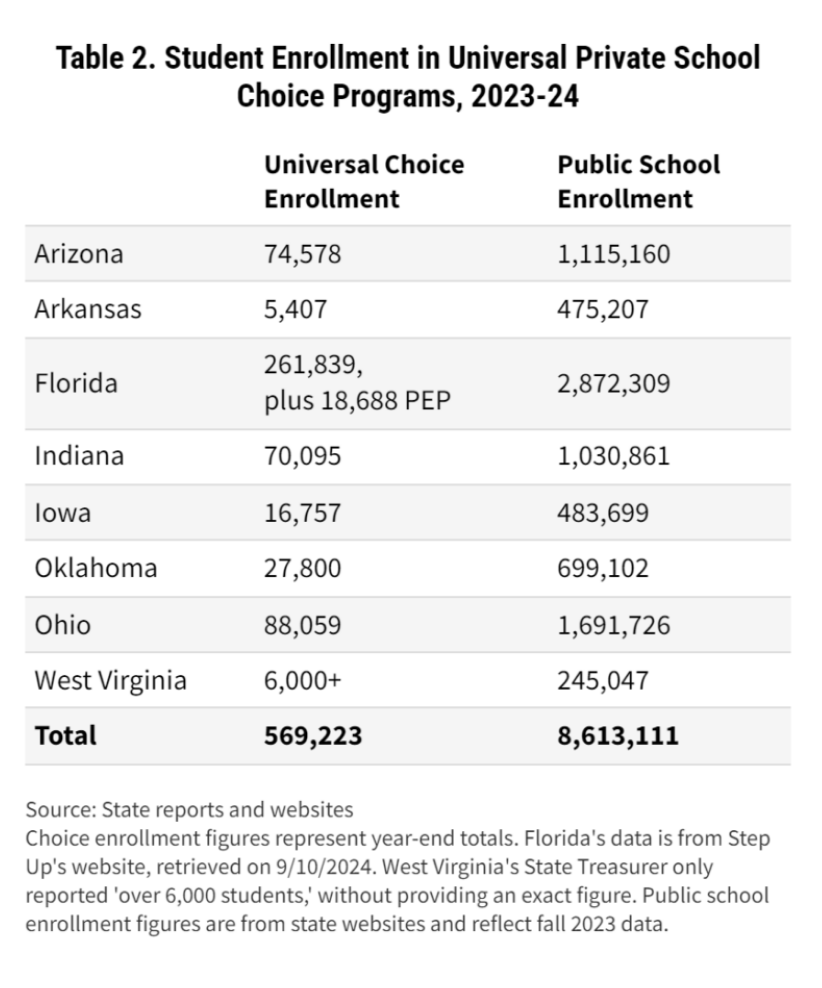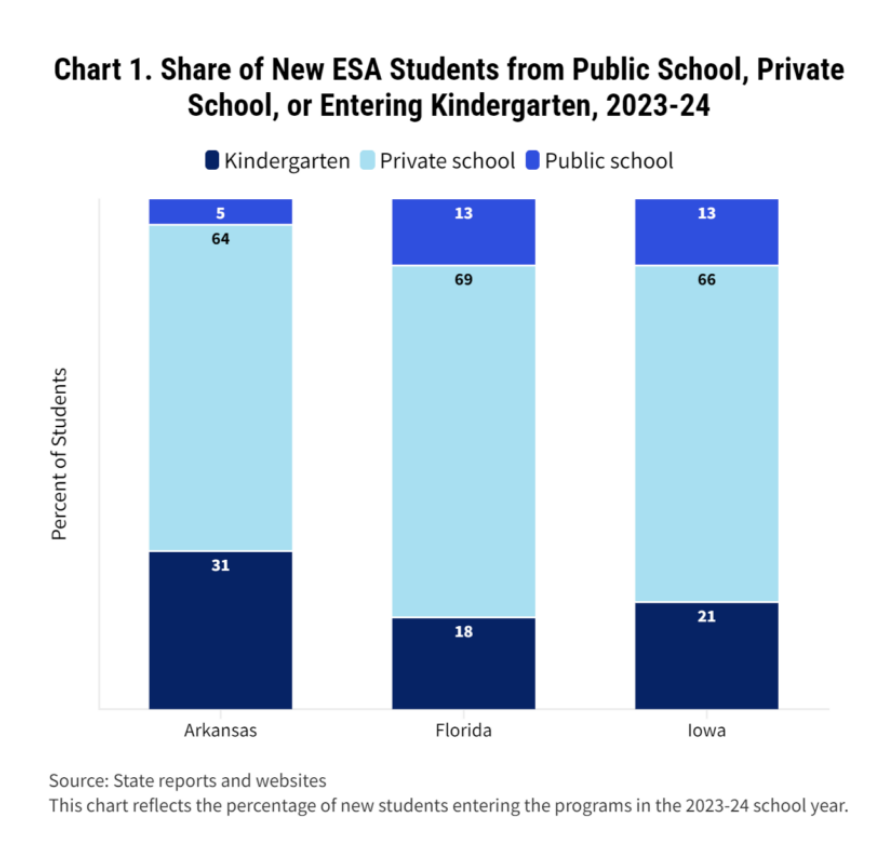
|
|
While many states — including North Carolina — have recently enacted legislation to vastly expand their private school voucher programs, implementation and design varies greatly from state to state, according to a new Future Ed report.
These differences include the extent to which states help families navigate school choice options, impose budget or enrollment caps, prioritize funding based on needs, and track the performance of students receiving vouchers.
“These policy differences have important consequences for state spending, school quality, student learning, educational equity, and taxpayer protections, we found,” the Future Ed report says.
Per the report, states began private school voucher programs in 1990. At the time, most of those programs were small and meant to help low-income students, students with learning differences, and students attending low-performing schools.
“Over the past three years, the scope of these programs has expanded significantly,” the report says. “A decades-long campaign by school-choice proponents found a receptive audience in parents frustrated with public schooling during the pandemic, resulting in a striking expansion of private school choice and a dramatic rethinking of which students should be able to participate.”
Among the 33 states with private school choice programs, 12 states have laws allowing any student, regardless of income or need, to apply for government funding to subsidize their private education, per the report. As of the 2024-25 school year, North Carolina is one of those 12 states.
In the eight states where universal private school voucher programs were running during the 2023-24 school year, 569,000 students received public subsidies for private schooling, according to the report. The vouchers for those students cost taxpayers approximately $4 billion.
“Never in the history of American public education has so much money been available to parents to pay for private school tuition or homeschool expenses,” the report says. “And universal private school choice appears set to expand further.”
As North Carolina and other states are poised to further expand their voucher programs, the Future Ed report offers analysis of the eight states that offered universal vouchers in 2023-24: Arizona, Arkansas, Florida, Iowa, Indiana, Ohio, Oklahoma, and West Virginia.

Future Ed “also gathered early insights from programs launching in North Carolina and Utah this year, as well as programs in Alabama and Louisiana launching in 2025-26.”
“Our portrait of the universal private school choice movement in 2023-24 suggests that it’s likely to present state policymakers with difficult decisions about the size and shape of the new choice plans,” the report says, “given their emerging impact on state budgets, public school funding and enrollments, longstanding efforts to strengthen educational opportunities for low-income students, and even the sustainability of public charter schools.”
Read more about NC’s voucher program
First, some context
In North Carolina, the Republican-led General Assembly removed income eligibility requirements and expanded funding for the state’s voucher program, known as Opportunity Scholarship Grant Program, in 2023. This led to approximately 70,000 new applications for private school vouchers for the 2024-25 academic year.
While North Carolina’s voucher program is now universal, it still prioritizes funding based on income level, organized into four tiers.
The North Carolina State Education Assistance Authority (NCSEAA) — the state agency designated by law to administer K-12 scholarship programs — offered vouchers to 15,805 new students, mostly low- and middle-income students. That leaves nearly 55,000 students on the waitlist.
A mini budget bill passed by the General Assembly last month would effectively clear that waitlist, allocating approximately $463 million toward Opportunity Scholarships this fiscal year. It also includes $24.7 million in recurring funds to clear the Education Student Accounts (ESA+) waitlist for students with disabilities.
“The mini budget strengthens our commitment to school choice for all NC families as well as public education, with historic investments in enrollment growth for both K-12 public schools and our community colleges,” House Speaker Tim Moore, R-Cleveland, said at the time.
The mini budget was vetoed by Democratic Gov. Roy Cooper, who has said public funding should not go toward private schools. The General Assembly is expected to take up a veto override on the mini budget when it reconvenes Nov. 19-22.
According to the Future Ed report, state typically use three primary methods in their choice programs:
- Vouchers provide parents with some portion of their child’s state education funding in the form of a “coupon” to pay for tuition at a private school.
- Education savings accounts (ESAs) allow parents to withdraw state funds deposited into individual accounts to pay for private school tuition, online learning, tutoring programs, or other approved educational expenses.
- Tax-credit scholarships allow taxpayers, both individuals and businesses, to receive tax credits when they donate to nonprofit organizations that provide private school scholarships. Some states also use a refundable tax credit.
Some states — like North Carolina — give money directly to schools and limit expenses to tuition, while other states give money to parents and allow them to spend it “on a wide range of educational expenses.”
Some states allow homeschoolers to access funds. (In North Carolina, a bill was proposed in 2023 to allow homeschoolers to access voucher funding, but it did not move forward.)
According to the Future Ed report, states with universal choice programs typically offer vouchers that are “the equivalent of about 90 percent of a state’s per-pupil funding of public schools.”
Local and federal dollars do not follow students to private school.


Some of the public funding for universal choice programs “comes from state coffers,” the report found, rather than state K-12 education budgets. That is true in North Carolina, where the Opportunity Scholarship Program is housed under the UNC System’s budget.
Some states, like Utah, have capped participation and set budget limits for the new universal programs. Other states, like Arizona and Florida, give funds to any student who applies.
“The cost-overruns stem in large part from lawmakers’ underestimation of the predictable enthusiasm for the new subsidies among families already paying private school tuition,” the Future Ed report says. “In Iowa, for example, lawmakers projected about 6,000 existing private school students would use the state’s ESA for the 2023-24 school year; the actual number exceeded 11,100.”
The impact of universal voucher programs on individual school districts varies greatly, per the report.
“While public schools are not yet losing large numbers of students to the private sector under the new universal choice programs (the 569,000 students in the programs last year represent about 7 percent of the 8.6 million public school students in the eight states we studied), opponents argue that the increased state education funds needed to support the programs could be better used to enhance public education,” the report says.
Highlights from the report
Implementation of universal funding matters
Arkansas, Iowa, and West Virginia are phasing in their universal choice programs, meaning they haven’t yet reached all-student eligibility for the program. Oklahoma and Arkansas have capped the number of participating students. In Florida and Arizona, however, every student who applies receives some funding.
“Though that doesn’t guarantee students a place in a school of their choice; application requirements and the availability of private school seats ultimately influences who participates in the states’ universal programs,” the report says.
Representation of students already enrolled in private schools
“Universal choice programs have initially served primarily children already enrolled in private schools.” This tracks with predictions made by the Department of Public Instruction (DPI) last year.
In Arkansas, for example, 64% of students who received funds through the state’s Education Freedom Account (EFA) for the 2023-24 school year were already enrolled in private schools. Most of them were students with disabilities, per the report.
Only 5% of Arkansas recipients in 2023-24 transferred from public schools.

The report found similar trends in Iowa and Arizona.
“Data from Iowa indicates that public-school families were aware of and initially interested in the ESA program,” the report says.
Other factors, per the report, include the fact that private schools can reject applicants. In other words, funding does not guarantee admission. In North Carolina, opponents to voucher expansion have cited the fact that many private schools do not serve students with learning differences, and many religious schools — which make up 65% of private schools in North Carolina — prohibit LGBTQ+ students or students from different faith backgrounds from attending.
However, the report also found that the participation of public school students tends to rise in subsequent years of the universal voucher plan’s implementation.

“Choice advocates express confidence that the marketplace would produce more private educational providers, though the cost and complexity of creating high-quality schools from scratch have proven daunting challenges in both the independent school and charter school sectors,” the report says.
Representation of rural students
The majority of private schools participating in the new universal choice programs are urban and suburban, according to the report. In North Carolina, many rural counties have none or few private schools, with many private schools concentrated in urban and suburban areas.
“The lack of available options in rural areas has contributed to many rural Texas lawmakers opposing a universal private school choice program that Governor Greg Abbott has sought for several years,” the report says.
Income distribution
While private school choice programs largely serve lower-and middle-income households, Future Ed “found that participation among higher-income families increased in 2023-24 in every state where eligibility expanded and income information was available.”
In Florida, for example, “nearly half of the state’s new ESA recipients came from families earning over 400 percent of the federal poverty level (about $125,000 for a family of four), while a third came from families eligible for free or reduced lunch.”
In Ohio, 67 percent of families in the state’s universal private school choice program were low-income before the program was expanded to include all families. After the expansion, the figure dropped to 17 percent, in 2023-24. Ohio requires private schools to accept vouchers as full tuition for families with incomes at or below 200 percent of the federal poverty level, or $62,400 a year for a family of four. The state does not report information on the incomes of families in the program above that threshold.
Future Ed report

Some states, like Utah and Oklahoma, prioritize applicants by income level, meaning voucher funding primarily goes to lower- and middle-income families.
In North Carolina, despite the expansion of vouchers to all families, because the number of applicants exceeded available funding, students from higher-income families were originally not set to receive vouchers.
“But in September 2024, days into the new school year, the state legislature approved funding to clear the program’s 55,000-student waitlist, including some 13,000 students from families earning $260,000 or more,” the report says.
Racial disparities
“While only Ohio and Indiana currently make racial and ethnic data available on private school choice participation across years, there has been an increase in the participation of white students in those states as eligibility has expanded,” the report found.
In both of those states, the makeup of public school students is now more diverse than the makeup of students receiving private school vouchers.
Growing participation of kindergarteners
The report found the kindergarten students have typically shown the highest rates of participation in new universal choice programs.
As the report notes, the availability of private school seats is also likely the highest in kindergarten.
“While we can’t say how many families would have enrolled their kindergarteners in private school without ESA funds, it is reasonable to suggest more families in these states are opting for private education from an early stage as a result of universal eligibility,” the report found.
Academic performance
The report offers insight into how students receiving vouchers perform academically.
Each state with a universal private school program in 2023-24 required academic assessments of participants, except for Arizona and Oklahoma. However, these tests are not often comparable to public school testing.

“But without standardized testing requirements or other performance metrics in Arizona and Oklahoma, it is nearly impossible to gauge how much learning is taking place under the state’s private school choice programs. That challenge is compounded by the fact that none of the states have clearly defined the purpose of the new universal programs, beyond the expansion of school choice,” the report says. “But choice proponents have not articulated educational outcomes that they hope the new programs achieve.”
Florida is the only state in the analysis that has mandated funding to evaluate student academic performance in its universal choice program, the report said.
You can read the full report on Future Ed’s website.
Plus, a brief look at other new ed reports
In addition to the Future Ed report, several other important education-related reports have recently been published.
Earlier this month, the Education Futures Council (EFC) released its report, “Ours to Solve, Once – and For All,” to outline a new framework for revitalizing public K–12 education across the nation.
“Schools operated and overseen by local school boards―often called ‘traditional’ or ‘district’ schools―enroll 75 percent of all students in the United States and will continue to be a prominent part of the education landscape no matter what other schooling choices exist,” an introduction to that report says.
The report includes several components of a “new operating system for K-12 public education:”
- Organize system-wide for student results,
- Flip the system from top-down to bottom-up,
- Minimize mandates, embrace incentives, and
- Cultivate and reward professional mastery in the educator workforce.
“The Council was unanimous in the view that dramatic action is no longer a matter of public urgency; it is a matter of public emergency,” the report introduction says. “High-performing public schools are one of the cornerstones of a safe and healthy democracy. Providing a consistently high quality of education to all students, in all communities, entails a unique public trust, and the success or failure of that endeavor has a direct and determinative effect on the future prosperity and security of our country.”
Another report, from the National Partnership for Student Success, examines findings from the 2023-24 survey of school principals.
According to the report, an estimated 323,000 additional adults stepped up to serve in student support roles in public schools between fall 2022 and spring 2024.
“In no small feat, tens of thousands of schools significantly increased their capacity to provide high-intensity tutoring, mentoring, college/career advising, or wraparound supports in a single school year–for the second year in a row–by adding staff or partnering with student support providers, nonprofits, or colleges,” the report says.
Finally, 15 North Carolina school districts are leading the first wave of schools nationally to receive Certified Opportunity Culture School™ status, according to a recent press release.
To earn this designation, school districts “have implemented innovative models that extend the reach of excellent teachers and the small teams they lead to more students, for more pay, within regular school budgets.”
“Opportunity Culture models have served a critical role in retaining teachers and expanding the reach of our highest-performing educators,” Charlotte-Mecklenburg Schools (CMS) Superintendent Dr. Crystal Hill said. “Over a decade ago, in partnership with Public Impact, Charlotte-Mecklenburg Schools had the privilege of pioneering one of the nation’s first advanced teaching role initiatives. CMS remains committed to being a beacon for other districts implementing Opportunity Culture models by sharing resources, hosting site visits and continuing our culture of collaboration.”
You can learn more about the designation here.








